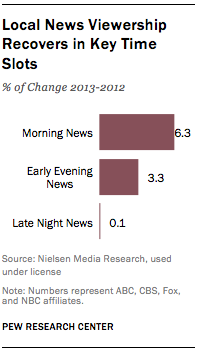Wild car chases, crazy manhunts, big storms, and a couple of other items of seemingly no importance at all: Welcome to your trusty local television news broadcast.
The audience for this kind of programming has shrunk consistently in recent years, with late night, early evening, and morning broadcasts all losing viewers between 2008 and 2012, except for a slight bump in 2011. But Pew Research Center’s evaluation of the Nielsen ratings for 2013 makes the future look a bit brighter than usual for the Dallas Raines, Skip Waters, and Johnny Mountains of our world. According to Pew:
Bucking a long-range trend of declining viewership, the audience for local TV news grew in all three major time slots in 2013. Viewership climbed 6% in the morning (5 to 7 a.m.) and 3% in the early evening (5 to 7 p.m.) newscasts, according to a new Pew Research Center analysis. The audience barely edged up—by .1%—in the late night slot (11 p.m.), a newscast that had suffered the biggest decreases in recent years.
As Pew notes, these modest jumps may be linked to some big-ticket news events that occurred when the ratings were measured. November, for example, saw some “big weather events, including tornadoes in the Midwest, and floods in Texas, Louisiana and Mississippi.” And February brought Los Angeles viewers the manhunt for deranged former LAPD officer Christopher Dorner.

Overall, though, the numbers are still sloping downward. When compared to 2007’s stats, viewership in the late night category has declined by 17 percent.
Local television broadcasts remain the American public’s top source for news, outperforming both network and cable channels. About 71 percent of Americans tune in, according to Pew.
If local television reporters and anchors continue to supply the masses with these type of amazing Vaudevillian bloopers, perhaps they can continue to make gains:
https://www.youtube.com/watch?v=7OihpIHUYYU




